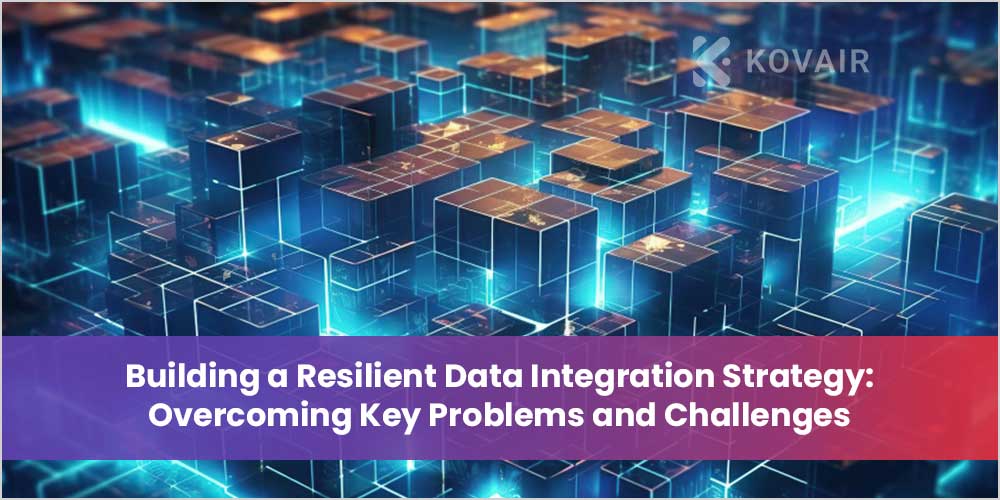
A practical data integration strategy can strongly handle disruptions. Consider data silos and interoperability, launch of new technologies, and the ever-changing landscape of regulations can be a cause of hurdles in the operational environment. If organizations focus on building resilience, data integration efforts will be effective and also sustainable in the long run.
Let us closely look at the enterprise data integration challenges prevalent nowadays:
- Data Silos: Many organizations face a tough challenge when it comes to having their data stuck in isolated systems. Accessing and integrating this information across departments becomes difficult. This can create all sorts of inefficiencies and a lack of comprehensive insights.
- Data Quality Issues: Keeping data accurate, consistent, and complete is not an easy task. When the quality of data is lacking, it can lead to wrong analyses and incompetent decisions.
- Complexity of Integration: The growing number of data sources, cloud services, on-premises systems, and third-party apps collectively makes the integration process challenging. Enterprises should upgrade to advanced tools and implement smart strategies to manage data skillfully.
- Regulatory Compliance: Organizations must navigate various regulations regarding data privacy and security, such as GDPR and HIPAA, which can complicate data integration efforts and necessitate additional compliance measures.
- Scalability and Performance: As the amount of data expands, it becomes a challenge to manage integration solutions without losing performance. It is all about having a solid infrastructure in place and fine-tuning processes for consistent performance.
How Does Resilient Data Architecture Help to Maintain Data Quality and Consistency
Strengthening a data architecture indirectly strengthens the enterprise’s core, with data quality and consistency in sync. It is like a shield that strongly overcomes challenges related to system failures, data corruption, or sudden data volume spikes:
- Structured Data Management: Structured frameworks maintain a resilient data architecture. Consistent data storage is crucial to guaranteeing the quality of the data. By adhering to specific schemas and standards, businesses can significantly reduce errors and inconsistencies that arise during data entry and processing.
- Redundancy and Backup Mechanisms: A strong data architecture comprehensively consists of reliable backup systems and redundancy in place. By storing data copies in different spots, companies can still retrieve their information in times of crisis, like a system crash or data corruption.
- Real-time Data Validation: Real-time data validation processes have a hawk eye to spot and rectify data quality issues, if any. The automation in the validation procedure verifies that only high-quality, consistent data is entered into their systems, thereby enhancing overall data reliability.
- Scalability and Flexibility: Resilient data architectures count when it comes to being both scalable and flexible. They let organizations adapt to changing data needs as their data needs shift, all while keeping quality intact. This kind of adaptability signifies the strength of the existing data architecture, with the capability of keeping data consistency and quality intact.
- Comprehensive Monitoring and Auditing: Implementation of comprehensive monitoring and auditing mechanisms tracks data changes and access patterns, enabling organizations to quickly identify inconsistencies. Regular audits ensure everything stays on track with data quality standards.
How Do Extract, Transform, Load (ETL) and Extract, Load, Transform (ELT) Processes Support Real-time Data Integration
Data integration is bound by structured processes such as Extract, Transform, Load (ETL) and Extract, Load, Transform (ELT). Enterprises often get assistance with ETL and ELT to efficiently manage data in real time. The ETL and ELT processes enable seamless real-time data integration, transforming and tweaking raw data while the queries are running.
With ETL, you start with data collation from the accurate sources. Then, transform the extracted data into a structured format, and finally, load it into a target system, usually a data warehouse. Mostly, this process is covered in batches to process data at scheduled times. Thanks to some nifty advancements in ETL tools, we are now seeing real-time processing and can enable organizations to make decisions based on the latest data. Besides, the ELT process involves transforming data before loading it. You first extract it and load it straight into a target system, data lakes, or cloud storage. Then comes the best part, as users can transform that data whenever needed.
The power of modern data platforms is immense. They are built to handle tons of data efficiently in real-time without getting stuck in the delays that are often the case with traditional ETL processes. That’s why more and more organizations are leaning towards ELT to be quick and responsive with their data operations.
Conclusion: Data Integration Best Practices Benefitting Data Modernization Services
Data integration is a key aspect of data modernization services. It helps organizations collect all sorts of data from different sources into one clear picture. One clear practice to streamline data integration is using a modular approach. It explicitly includes breaking down the integration into smaller, bite-sized pieces. This makes it way easier for companies to adapt when their data needs change or when they need to bring in new sources of data. Also, including the automation tools is another best practice that boosts how efficiently all this data integration occurs. By using these tools, organizations can cut down on the time and effort it takes to manage data flows. Plus, it helps keep everything up-to-date and accurate.
Adhering to the practice of data quality and governance is essential through the integration process to have clear data governance policies in place. This will ensure the data you are working with is accurate, consistent, and meets all the necessary regulations. Besides, data validation and cleansing techniques during integration can polish the data quality, making it highly insightful.
Lastly, a collaboration of IT and business teams matters for the success of data integration. This kind of teamwork promotes a culture where decisions are driven by data, which is a huge win for any data modernization effort.
